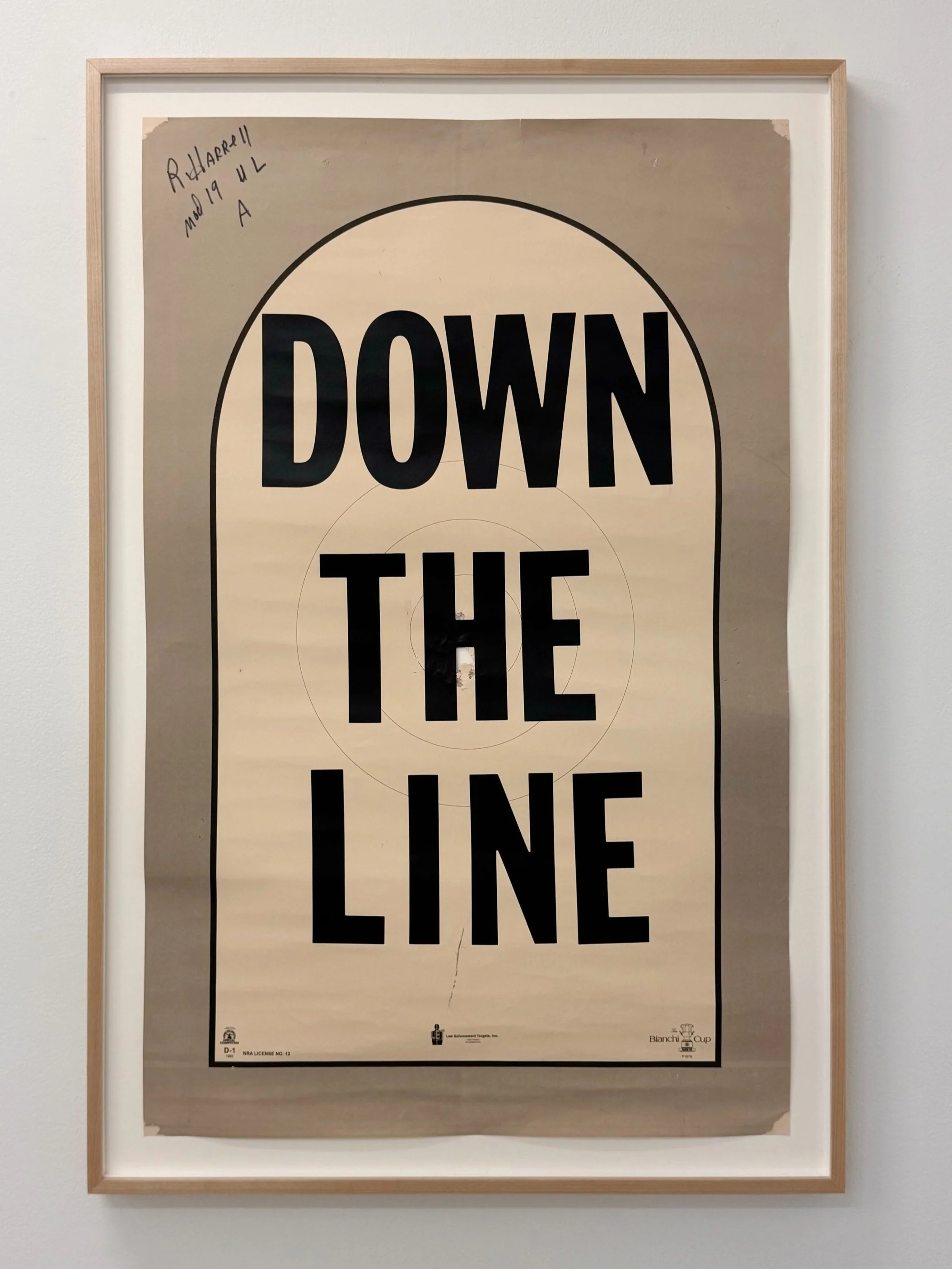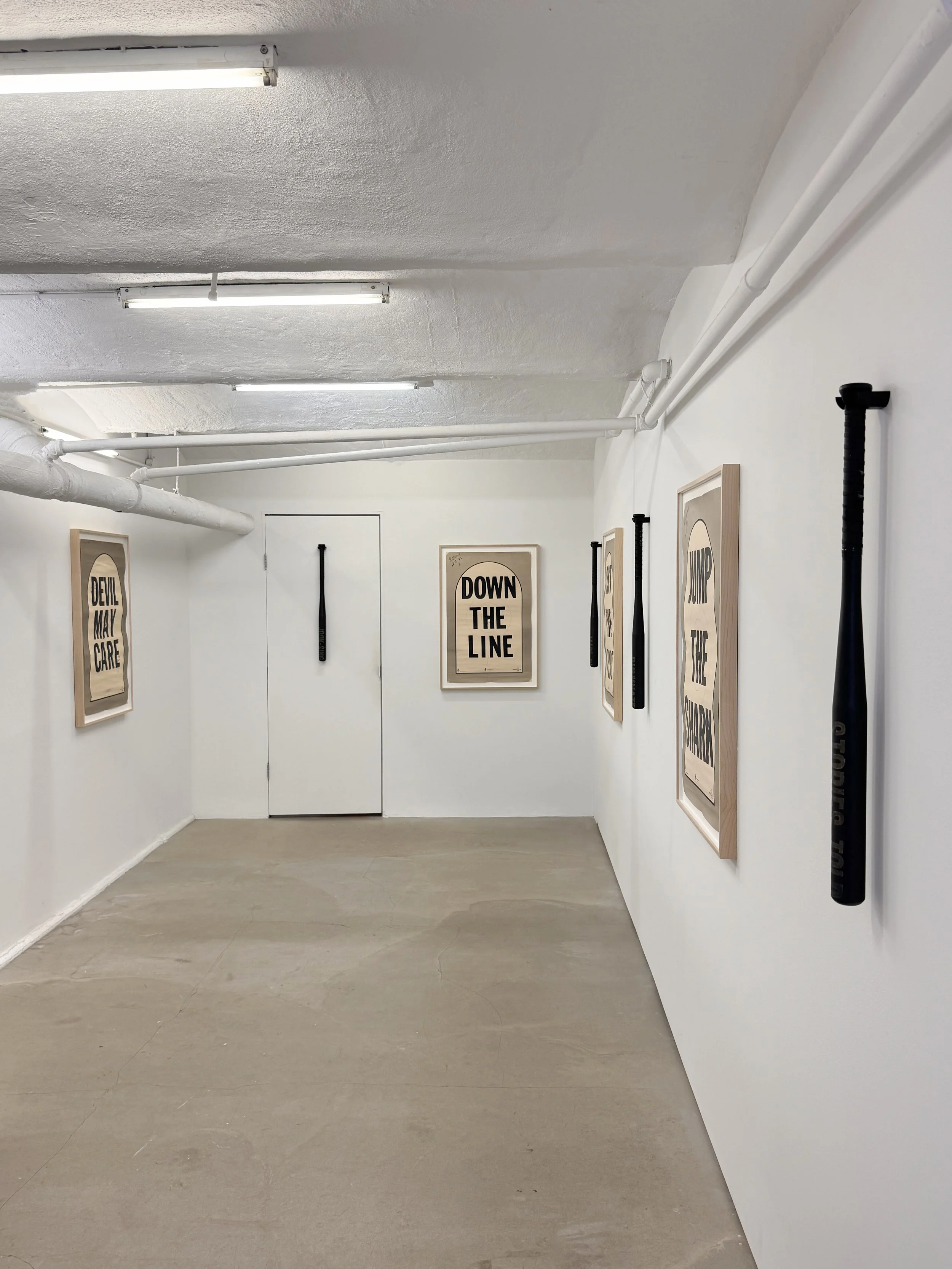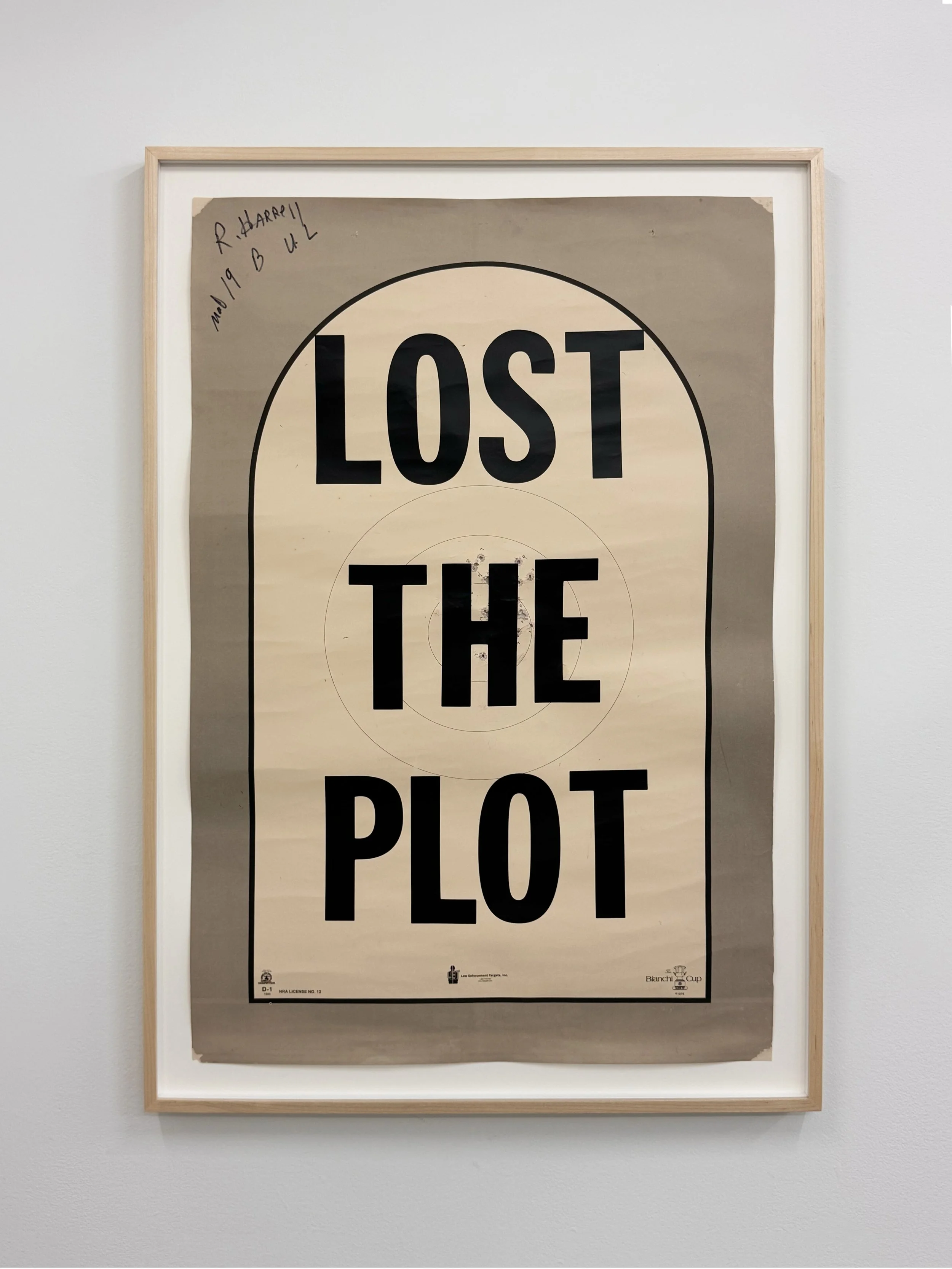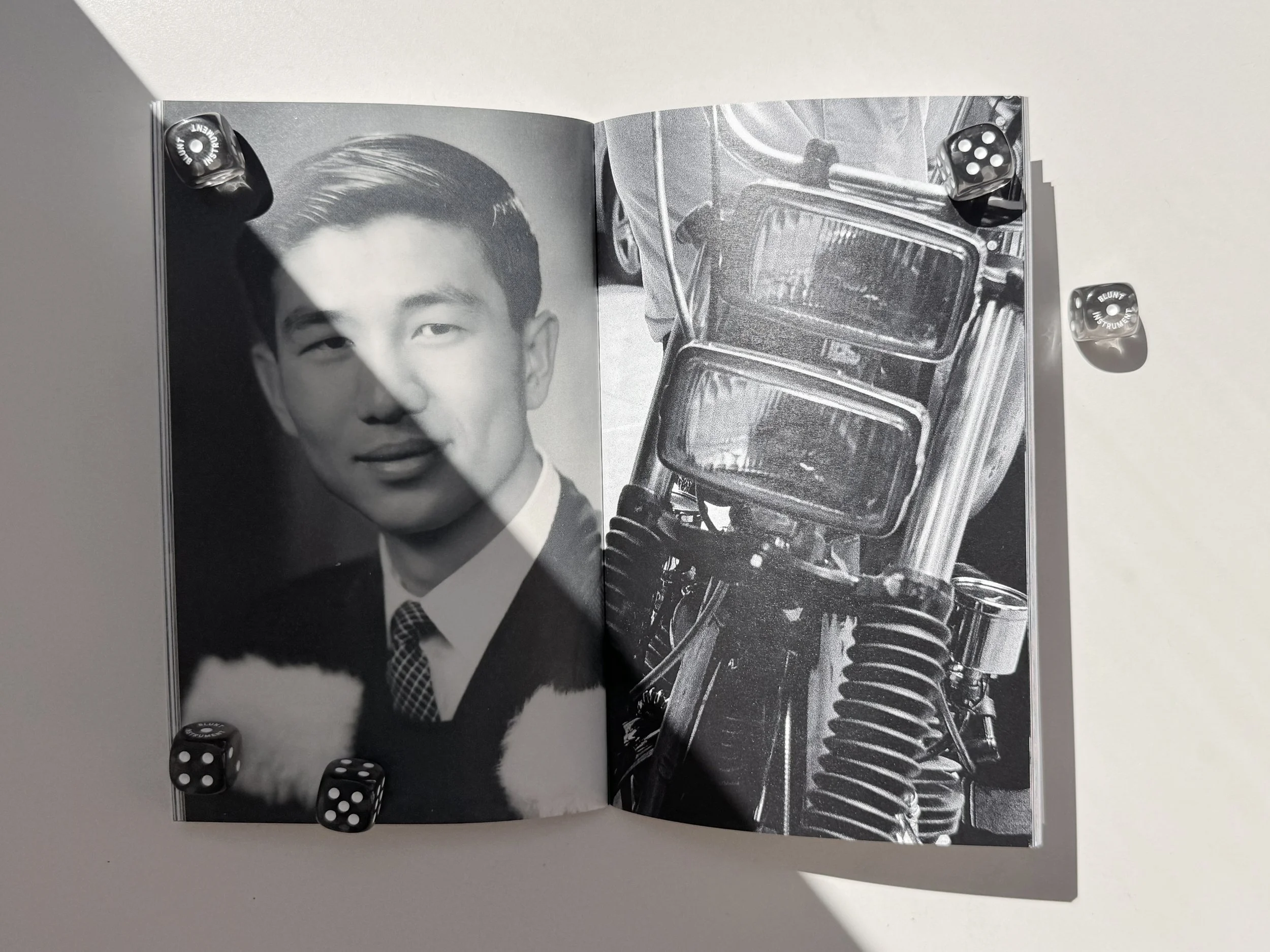Matt King, King Chong, 2018-2025
1981 Yamaha XS650 chopper in a custom American steel Hardtail Frame
51 x 81 x 29 inches (129.5 x 205.7 x 73.7 cm)
Matt King, Down the Line , 2025
Gun range posters, letraset type, maple frame
38 3/4 x 26 1/2 inches (98.4 x 67.3 cm)
Every surface, every phrase, every object we encounter offers a kind of signal. Some of those signals pass through us without friction. Others catch. They slow us down.They ask to be considered, even if they never quite explain themselves. And we respond—not always with understanding, but with feeling.
The act of moving through language is like moving across a road: we are constantly, consciously or unconsciously, rating its roughness. We register texture. We measure impact. We assess whether it carries us smoothly, or whether something in it feels unstable. Meaning, in this sense, is not only decoded—it’s experienced.
“The roughness of highway pavements is of concern to highway users and to highway engineers. Usually, whenever a highway user travels over a stretch of highway he consciously or unconsciously rates the roughness of the ride...”
— PCA ROAD METER MEASURING ROAD ROUGHNESS AT 50 MPH, G.
J. Chong and W. A. Phang
Matt King, Jump the Shark , 2025
Gun range posters, letraset type, male frame
38 3/4 x 26 1/2 inches (98.4 x 67.3 cm)
Blunt Instruments is a meditation on that experience. On the way signs—words, objects, phrases—take on meaning not only through design, but through use. Through repetition. Through erosion. Through what Barthes called the mythologies, where language detaches from its origins and becomes structure, system, symbol. The blunt sign is not crude. It is dense.Worn by time. Overloaded. It no longer serves its original function cleanly. It resists quick reading It accumulates meaning rather than clarifies it. It becomes what Barthes might describe as obtuse—a third layer of meaning, felt rather than named. Not what the sign says, and not what it’s meant to represent, but the atmosphere it creates. The noise it carries.
Matt King,Instrument, 2025
Aluminium baseball bat, acid etching
32 x 2 x 2 inches (81.3 x 5.1 x 5.1 cm)
Matt King, Over the Hill, 2025
Gun range posters, letraset type, maple frame
38 3/4 x 26 1/2 inches (98.4 x 67.3 cm)
Ruminate, 2025
Jook-Sing, 2025
Stories Told, 2025
Heavy handed, 2025
Run Home, 2025
Made in, 2025
Aluminium baseball bat, acid etching
32 x 2 x 2 inches (81.3 x 5.1 x 5.1 cm)
To live among such signs is to ride down a gravel road.Familiar forms present themselves clearly, but carry hidden infrastructures of thought. They may appear blunt, but they’re not empty. Their roughness is not just wear—it is information.
This work doesn’t ask for an explanation. It asks for attention. For sensitivity to what’s been passed down, repeated, flattened, or made into symbols. It invites the viewer to sense the gap between intention and reception. Between what was once said and what is now felt.
There is no one reading.
There is only the ride.
Matt King, Devil May Care, 2025
Gun range posters, letraset type, maple frame
38.75 x 26.5 inches (98.4 x 67.3 cm)
Matt King, Lost the Plot, 2025
Gun range posters, letraset type, maple frame
38 3/4 x 26 1/2 inches (98.4 x 67.3 cm)
Matt King (b. Los Angeles, CA) is a New York based artist who works with collage, sculpture, and printmaking under Work.Rodeo. King’s work focuses on semiotics and language, weaving in personal and pop cultural references through his multidisciplinary practice.
King holds a BFA from CalArts (2013) and maintains a design practice that has been recognized by ADC Best in Show, Cannes Gold Lion, and ONE SHOW Gold Pencil. His fine art practice explores the intersections of visual communication and cultural identity, often drawing from family history and industrial heritage.
His works have been featured in the Tang Teaching Museum and LACMA’s permanent collection, with recent exhibitions including solo shows “For What its Worth” at Paradise (2022) and “The Smokers” at The Crude Plant (2019), as well as group exhibitions at Ace Hotel NYC and REDCAT. Featured in publications including Concept of the Year Vol. 3 and Inside out & Upside down: Posters from CalArts, bridging commercial design and fine art through investigations of visual language, cultural symbols, and the semiotics of everyday objects.
Matt King, Dime a Dozen, 2025
Gun range posters, letraset type, maple frame
38 3/4 x 26 1/2 inches (98.4 x 67.3 cm)
Matt King's BLUNT INSTRUMENT, launched alongside his exhibition of the same name, explores the worn surfaces of language and meaning through a deeply personal lens. Drawing inspiration from his grandfather's engineering work measuring highway roughness, King constructs a meditation on how we navigate the cultural infrastructure of signs and symbols. The book begins with a poignant family story about his Gung Gung, a civil engineer who studied road surfaces and their subjective impact on travelers, creating an unexpected parallel between the technical measurement of pavement roughness and our unconscious registration of language's texture and weight.
King's central thesis treats language as infrastructure—something that ages, cracks, and accumulates layers of meaning over time. He argues that signs and phrases function like "patched-over surfaces, repaved meanings" that resist quick reading and become dense with accumulated use. Rather than offering clean answers or interpretations, BLUNT INSTRUMENT presents itself as "a field test, a calibration site" where readers can experience how cultural signs have been worn down by repetition and misuse. The book asks readers to slow down and feel the friction of language, to register not just what words were meant to say, but what they communicate now after being driven over by countless users across time.
Copies are available at the gallery.
For inquiries, email info@entrance.nyc












